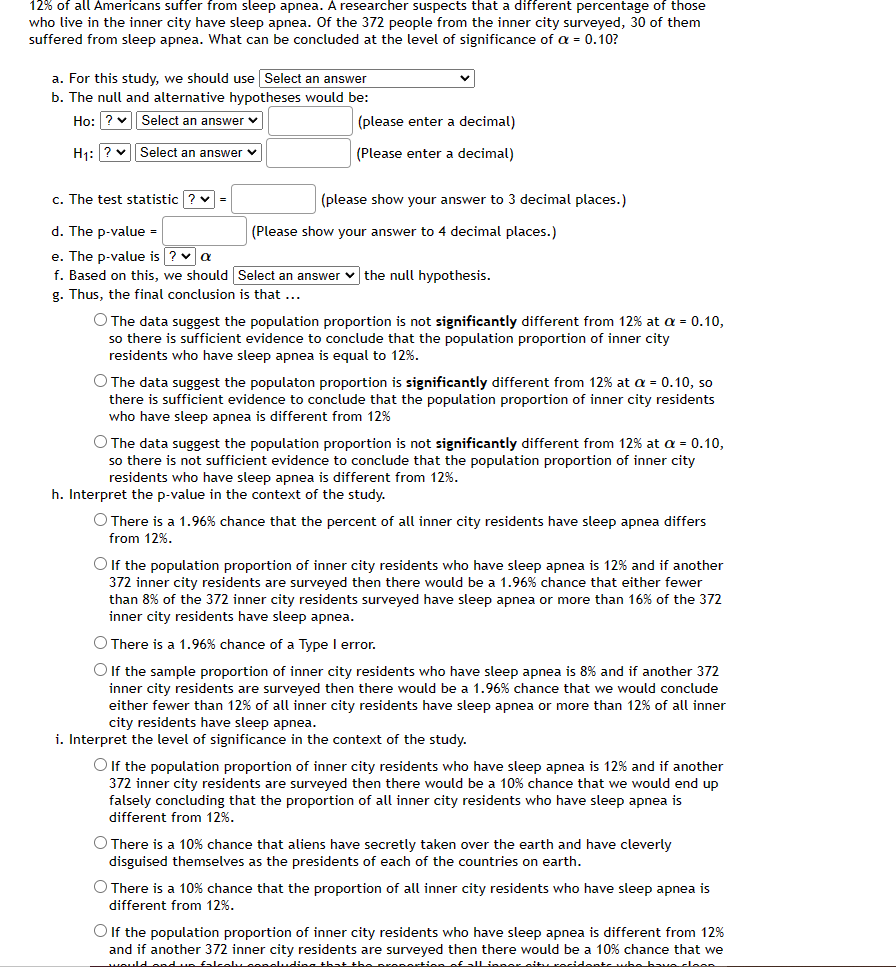12% of all Americans suffer from sleep apnea. A researcher suspects that a different percentage of those who live in the inner city have sleep apnea. Of the 372 people from the inner city surveyed, 30 of them suffered from sleep apnea. What can be concluded at the level of significance of a = 0.10? a. For this study, we should use Select an answer b. The null and alternative hypotheses would be: Ho: ? Select an answer v (please enter a decimal) H1: ? Select an answer (Please enter a decimal) c. The test statistic ? v = (please show your answer to 3 decimal places.)
12% of all Americans suffer from sleep apnea. A researcher suspects that a different percentage of those who live in the inner city have sleep apnea. Of the 372 people from the inner city surveyed, 30 of them suffered from sleep apnea. What can be concluded at the level of significance of a = 0.10? a. For this study, we should use Select an answer b. The null and alternative hypotheses would be: Ho: ? Select an answer v (please enter a decimal) H1: ? Select an answer (Please enter a decimal) c. The test statistic ? v = (please show your answer to 3 decimal places.)
Holt Mcdougal Larson Pre-algebra: Student Edition 2012
1st Edition
ISBN:9780547587776
Author:HOLT MCDOUGAL
Publisher:HOLT MCDOUGAL
Chapter11: Data Analysis And Probability
Section: Chapter Questions
Problem 8CR
Related questions
Question

Transcribed Image Text:12% of all Americans suffer from sleep apnea. A researcher suspects that a different percentage of those
who live in the inner city have sleep apnea. Of the 372 people from the inner city surveyed, 30 of them
suffered from sleep apnea. What can be concluded at the level of significance of a = 0.10?
a. For this study, we should use Select an answer
b. The null and alternative hypotheses would be:
Ho: ? v Select an answer v
(please enter a decimal)
H1: ? v Select an answer v
(Please enter a decimal)
c. The test statistic ? v =
(please show your answer to 3 decimal places.)
d. The p-value =
(Please show your answer to 4 decimal places.)
e. The p-value is ? v a
f. Based on this, we should Select an answer v the null hypothesis.
g. Thus, the final conclusion is that ...
O The data suggest the population proportion is not significantly different from 12% at a = 0.10,
so there is sufficient evidence to conclude that the population proportion of inner city
residents who have sleep apnea is equal to 12%.
O The data suggest the populaton proportion is significantly different from 12% at a = 0.10, so
sufficient evidence to conclude that the population proportion of inner city residents
there
who have sleep apnea is different from 12%
O The data suggest the population proportion is not significantly different from 12% at a = 0.10,
so there is not sufficient evidence to conclude that the population proportion of inner city
residents who have sleep apnea is different from 12%.
h. Interpret the p-value in the context of the study.
O There is a 1.96% chance that the percent of all inner city residents have sleep apnea differs
from 12%.
Olf the population proportion of inner city residents who have sleep apnea is 12% and if another
372 inner city residents are surveyed then there would be a 1.96% chance that either fewer
than 8% of the 372 inner city residents surveyed have sleep apnea or more than 16% of the 372
inner city residents have sleep apnea.
O There is a 1.96% chance of a Type I error.
If the sample proportion of inner city residents who have sleep apnea is 8% and if another 372
inner city residents are surveyed then there would be a 1.96% chance that we would conclude
either fewer than 12% of all inner city residents have sleep apnea or more than 12% of all inner
city residents have sleep apnea.
i. Interpret the level of significance in the context of the study.
O If the population proportion of inner city residents who have sleep apnea is 12% and if another
372 inner city residents are surveyed then there would be a 10% chance that we would end up
falsely concluding that the proportion of all inner city residents who have sleep apnea is
different from 12%.
O There is a 10% chance that aliens have secretly taken over the earth and have cleverly
disguised themselves as the presidents of each of the countries on earth.
O There is a 10% chance that the proportion of all inner city residents who have sleep apnea is
different from 12%.
O lf the population proportion of inner city residents who have sleep apnea is different from 12%
and if another 372 inner city residents are surveyed then there would be a 10% chance that we
would ondun Ealcely oencludias that the prepertionof all ineer situ cocidente whe bave cloeR
Expert Solution
This question has been solved!
Explore an expertly crafted, step-by-step solution for a thorough understanding of key concepts.
Step by step
Solved in 3 steps with 2 images

Recommended textbooks for you

Holt Mcdougal Larson Pre-algebra: Student Edition…
Algebra
ISBN:
9780547587776
Author:
HOLT MCDOUGAL
Publisher:
HOLT MCDOUGAL

Holt Mcdougal Larson Pre-algebra: Student Edition…
Algebra
ISBN:
9780547587776
Author:
HOLT MCDOUGAL
Publisher:
HOLT MCDOUGAL